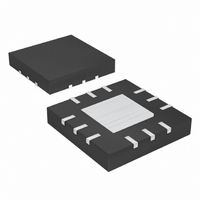MAX9725AETC+T Maxim Integrated Products, MAX9725AETC+T Datasheet - Page 8

MAX9725AETC+T
Manufacturer Part Number
MAX9725AETC+T
Description
IC AMP AUDIO .025W STER 12TQFN
Manufacturer
Maxim Integrated Products
Series
DirectDrive™r
Type
Class ABr
Datasheet
1.MAX9725CETCT.pdf
(17 pages)
Specifications of MAX9725AETC+T
Output Type
Headphones, 2-Channel (Stereo)
Max Output Power X Channels @ Load
25mW x 2 @ 16 Ohm
Voltage - Supply
900 mV ~ 1.8 V
Features
Depop, Short-Circuit Protection, Shutdown
Mounting Type
Surface Mount
Package / Case
12-TQFN Exposed Pad
Lead Free Status / RoHS Status
Lead free / RoHS Compliant
The MAX9725 stereo headphone driver features Maxim’s
DirectDrive architecture, eliminating the large output-cou-
pling capacitors required by conventional single-supply
headphone drivers. The MAX9725 consists of two 20mW
class AB headphone drivers, shutdown control, inverting
charge pump, internal gain-setting resistors, and compre-
hensive click-and-pop suppression circuitry (see the
Functional Diagrams ). A negative power supply (PV
created by inverting the positive supply (V
the drivers from V
range of the drivers to almost twice that of other 1V sin-
gle-supply drivers. This increase in dynamic range allows
for higher output power.
The outputs of the MAX9725 are biased about GND
(Figure 1). The benefit of this GND bias is that the driver
outputs do not have a DC component, thus large DC-
blocking capacitors are unnecessary. Eliminating the
DC-blocking capacitors on the output saves board
space, system cost, and improves frequency response.
Conventional single-supply headphone drivers have their
outputs biased about a nominal DC voltage (typically half
the supply) for maximum dynamic range. Large coupling
capacitors are needed to block the DC bias from the
headphones. Without these capacitors, a significant
amount of DC current flows to the headphone, resulting
in unnecessary power dissipation and possible damage
to both headphone and headphone driver.
Maxim’s DirectDrive architecture uses a charge pump
to create an internal negative supply voltage. This
allows the MAX9725 outputs to be biased about GND,
increasing the dynamic range while operating from a
single supply. A conventional amplifier powered from
1.5V ideally provides 18mW to a 16Ω load. The
MAX9725 provides 25mW to a 16Ω load. The
DirectDrive architecture eliminates the need for two
large (220µF, typ) DC-blocking capacitors on the out-
put. The MAX9725 charge pump requires two small
ceramic capacitors, conserving board space, reducing
cost, and improving the frequency response of the
headphone driver. See the Output Power vs. Charge-
Pump Capacitance and Load Resistance graph in the
Typical Operating Characteristics for details of the possi-
ble capacitor sizes.
1V, Low-Power, DirectDrive, Stereo Headphone
Amplifier with Shutdown
8
_______________________________________________________________________________________
DD
and PV
Detailed Description
SS
increases the dynamic
DirectDrive
DD
). Powering
SS
) is
Previous attempts to eliminate the output-coupling
capacitors involved biasing the headphone return
(sleeve) to the DC-bias voltage of the headphone
amplifiers. This method raises some issues:
•
•
•
Figure 1. Traditional Driver Output Waveform vs. MAX9725
Output Waveform (Ideal Case)
The sleeve is typically grounded to the chassis.
Using this biasing approach, the sleeve must be
isolated from system ground, complicating product
design.
During an ESD strike, the driver’s ESD structures
are the only path to system ground. The driver must
be able to withstand the full ESD strike.
When using the headphone jack as a line out to
other equipment, the bias voltage on the sleeve may
conflict with the ground potential from other equip-
ment, resulting in possible damage to the drivers.
V
V
OUT
OUT
CONVENTIONAL DRIVER-BIASING SCHEME
DirectDrive BIASING SCHEME
V
V
GND
V
GND
-V
DD
DD
DD
DD
/ 2












